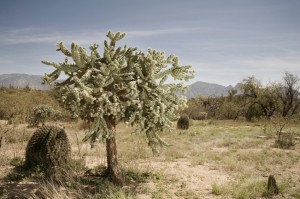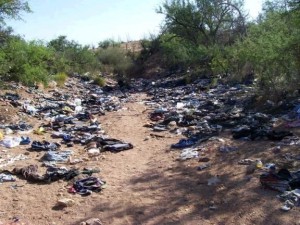An archaeologist dealing with a current event issue seems like an oxymoron, right? Most people are under the impression that archaeologists only study the ancient past. In reality, however, the goals of archaeology go far beyond finding hidden gems of prior time periods. Anthropologists also use archaeology as a means of studying modern day issues, such as illegal boarder crossing through the Sonora desert.

Sonoran Desert-North American desert covering large parts of the Southwestern United States and Northwestern Mexico
Since 2000, four and a half million people have been caught crossing the Sonora desert with the hopes of finding a better life in America. Along the way, approximately three hundred and thirty people will be caught each year and each day one person will die in their attempt to cross. While only a fraction of migrants will make it through the desert and live to tell their story, the items that they leave behind do all of the talking. As the migrants walk, they constantly leave behind material remains, making the Sonora desert an archaeologist’s wonderland.
In order to better analyze the people who choose to embark on the treacherous journey, Jason de León, author of “Better to be Hot than Caught,” studies the material culture of the Sonora desert. Using archaeological techniques, de Léon and his team can survey the desert and find artifacts that, combined, tell a story of the lives of migrants that cross the desert. While the Sonora is quite expansive and de León is not able to survey the entire desert, he has been able to compile a substantial amount of information.
In examining the material remains it quickly becomes clear that the migrants are quite misinformed regarding the items that will be most beneficial in crossing the desert; they are afraid of the wrong things. For example, in an effort to avoid detection, they wear dark clothing increasing their chance of heat-related illness. Additionally, most water bottles that are found have pictures of saints on them which show that the migrant’s culture is deeply rooted in religion.
These two examples illustrate how utilizing an archaeological approach can provide interesting insight into a modern cultural phenomenon. As an active member of Amnesty International, I knew a bit of background about the hardships faced by migrants in the Sonora desert. However, it was not until reading Jason de León’s work that I could truly contextualize the severity of the situation. Ultimately, Jason de Leóns “Undocumented Migration Project” has helped me, and hopefully many other people, understand more about the life of migrants in the Sonora desert, as well as opening people’s minds to the far-reaching influences of archaeological work.
References:
De León, Jason. “Introduction.” The Undocumented Migration Project. Word Press, n. d. Web. 8 Oct. 2013. <http://undocumentedmigrationproject.com/home/about/>.
Image 1: http://pri.org/sites/default/files/migration/PriMigrationsDamanticWordpressAttachmentsImagesMigration/www.theworld.org/wp-content/uploads/SONORAN.jpg
Image 2: http://thereaganwing.files.wordpress.com/2007/09/desert-2.jpg


De León’s work in the Sonora desert is both fascinating and potentially problematic; given the relatively high mortality rate of migrants that you cite here – 365 people dead a year – could there be an ethical imperative to help? Illegal migration into the United States is a politically touchy issue to put it mildly, and even a purely humanitarian move to provide aid for those attempting to cross the border illegally would be a huge affront to some Americans, who are particularly sensitive to a perceived risk to the American job market. Anthropologist Stephen Brighton, however, draws parallels with the Sororan migrants and the massive waves of European immigration of the 19th century, who faced a similar reception. He notes that descendants of these immigrants are now “part of the essential fabric of American life,” and he thinks the same will happen with those who make the trek across the desert. A humanitarian approach to migration wouldn’t even be new to American history; after all, emigrants from the Eastern United States had supply stations all along the Oregon Trail to help them in their journey. Could a similar system, with locations along a certain path selling specific necessities, be viable in this case? Some Americans, I think, would see this as encouraging illegal immigration. However, if the steady flow of people hasn’t been discouraged by the increasingly aggressive protocols of the Border Patrol, will it ever be? Can we use data like de León’s to better aid those who cross the Sonora desert? Should we?
For an article about Jason de León’s work, click here: http://archive.archaeology.org/1101/features/border.html
While Stephen Brighton raises a valid point in noting the parallels between European immigration and Sonoran migrants he fails to mention one crucial difference. While the Europeans were welcomed upon arriving in America (arriving legally, that is!), the Sonoran migrants will most likely get to the United States and promptly be deported to their country of origin.
To put it simply, the American government is unintentionally tricking illegal immigrants into crossing the desert, and often times, trekking to their eventual death. There are no gaurds in the Sonoran desert, so it proves an “easy” route to take to enter America. The debate on immigration laws is purely political, but right now, the American population does, indeed, have an ethical duty to stop Sonoran migrants from putting themselves in harms way.
The most important thing that Americans can do is educate the immigrants on the risks of crossing the desert. While selling supplies in the desert would be helpful, it would further encourage the migrants to trek through the Sonoran Desert. If we aren’t going to let them into the country, we cannot continue to let them think that the Sonoran Desert is the gateway to freedom.
For further reading on the danger of trekking the Sonoran desert: http://www.nature.com/news/2011/110411/full/news.2011.225.html